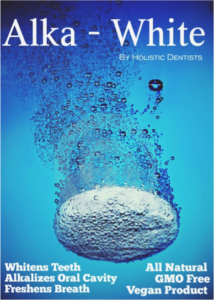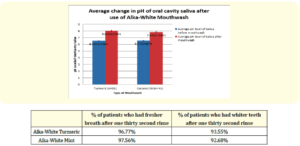Research Article
Sameer Atrash1* and Lewis Gross2
1Masters of Product Innovation, Virginia Commonwealth University da Vinci Center, United States of America
2Doctor of Dental Surgery, Columbia University School of Dentistry, United States of America
*Corresponding Author: Sameer Atrash, Masters of Product Innovation, Virginia Commonwealth University da Vinci Center, United
States of America.
Keywords: Alka-White Mint; Alka-White Turmeric; Mouthwash; Anti-Acidic; Alkalizing; Saliva; Oral Cavity
Introduction
Changes in microbial and environmental dynamics in microbial ecosystems may increase the potential for pathogenicity within a microbial
ecosystem and subsequently initiate and promote oral diseases [1]. These successional changes have recently and tentatively been
referred to by Marsh as the ecological plaque hypothesis [2]. Oral saliva pH is important because of its role in oral and systematic health.
Depending on the pH of saliva, it may demineralize or remineralize the tooth, cause or prevent decay, and may be an indicator of salivary gland pathology disorders.
In recent years, Dr. Lewis Gross, Columbia School of Dentistry Graduate and New York Holistic Dentist, had noticed an increasing prevalence in acidic saliva amongst his patients, and thus, created an oral care company which formulated two types of mouthwash to prevent his patients from the acidity. The purpose of this experiment is to provide evidence of effectiveness for two types of mouthwash, Alka-White, and Alka-White-Turmeric. The hypothesis is if Alka-White mouthwash is rinsed in the mouth vigorously for thirty seconds,
then the pH level of saliva of the oral cavity will increase significantly due to the alkalinizing chemical properties of sodium bicarbonate.
Sodium bicarbonate, also known as baking soda, is the only active ingredient of Alka-White and Alka-White Turmeric.
This notion stems from the abrasive properties of sodium bicarbonate. Sodium bicarbonate has been used as an antacid as well as advocated as an ingredient in
both toothpastes and mouth rinses. It has been generally regarded as a bactericidal agent that generates a hypertonic (causing water to
flow out of the cell) environment, leading to disruption of the fluid equilibrium of the cell and dehydration, plasmolysis (cell shrinkage due to loss of water by osmosis), and eventual cell death [4].
The main and only active ingredient for both products are sodium bicarbonate. However, the combination of different inactive ingredients, such as coconut oil, tea tree oil, and natural peppermint flavor may affect the cosmetic and therapeutic outcomes of the active ingredient, sodium bicarbonate. The purpose and significance of this study is to provide evidence of effectiveness for two types of mouthwash Alka-White and Alka-White Turmeric.
Materials and Methods
The effectiveness of mouthwashes will be established by taking three measurements before and after rinsing. The three measurements include pH in oral saliva, the freshness of breath and whitening effects. These measurements were recorded through different instruments:
Good America litmus paper to determine pH, patient feedback to attain freshness of breath and Schick intraoral camera to picture whitening effects. This will be done on two test groups which include: Alka-White Mint and Alka-White-Turmeric. The experiment will consist of a random selection of at least 30 patients for each test group and will be conducted at Holistic Dentists in Manhattan, New York.
To remain consistent, each patient will rinse for thirty seconds with the same amount of initial water solution of 100 millimeters. There will be no bias on patient population pool; however, the following data will be noted as introductory information with patient results:
name, gender, date of birth, race, and last time brushing, eating and drinking.
Material Company
Alka-White Mint Formulated by Dr. Gross and manufactured by Ameri-lab technologies. *
Alka-White Turmeric Formulated by Dr. Gross and manufactured by Ameri-lab technologies. *
Litmus paper pH Balance Life, P.O. Box 1893, Crystal Lake, IL. 60039
Intraoral camera Schick by Sirona Dental, USBCAM2
Patient Questionnaire Created by Mr. Sameer Atrash
Water New York Tap Water
Plastic cups BencoDental, Pittston, Pennsylvania
Gloves BencoDental, Pittston, Pennsylvania
The Effect of Alka-White Mint and Alka-White Turmeric on the Oral Cavity
Protocol:
1) Greet Patient, introduce yourself and collect all introductory information. All introductory information may be found above.
2) Before taking any measurements ask introductory questions 1-3, which can be located on the questionnaire manual found below.
3) Ask patient to spit in cup and place litmus paper on spit to measure initial pH of oral saliva.
4) Use intraoral camera device to take photos of gum baseline.
5) Introduce patient to product and explain to patient how it is used.
6) Place one full tablet in cup with 100-millimeter water solution.
7) Wait 30 seconds for dissolve time.
8) Allow patient to rinse mouthwash for thirty seconds.
9) Re take measurements of step 3 and 4.
10) Ask questions 4-10 from questionnaire manual.
11) Thank patient for taking time out of their day to be with you.
12) Fill out rest of questionnaire and patient summary form.
13) Plug in data to Microsoft excel and neatly organize physical results in file.
14) Make sure all data is neatly organized digitally as well as physically before seeing next patient.
Questionnaire Manual:
1) Which mouthwash do you currently use and is there a specific reason why you use that mouthwash?
2) What main factors drive you to buy certain mouthwash over others?
3) Price, flavor, brand, formulation and effectiveness are a few examples of factors.
4) Would you be interested in mouthwash that contains no alcohol and has natural essential oils and spices?
5) Did the mouthwash do an adequate job of removing malodor (bad breath)?
6) Would you say that you have fresher breath after rinsing with this mouthwash?
7) After reviewing the photos do you believe your teeth have gotten whiter?
8) What did you think overall of the product, were you satisfied?
9) If I were to ask you to describe this mouthwash to a friend, how would you describe and what would you say?
10) What adjustments would you recommend this product make?
11) Do you know of a relative or friend who would want this product? If so, why?
Patient Summary Form:
1) Name, gender, race, age, and last time brushing, eating and drinking:
2) Before and after: pH, freshness of breath, whitening of teeth:
3) Attitude about the overall process and product:
4) Biggest Wish/ Desire:
5) Flavor, price, point of purchase and other general insights:
6) Favorite Quote from interview:
Results
After conducting the protocol on 31 patients for Alka-White Turmeric and 41 patients for Alka-White Mint, the following results have been determined. The average pH of the oral cavity saliva after the use of Alka-White Turmeric was roughly 1.5, while Alka-White Mint was approximately 1.27. One patient out of the 31 patients that used Alka-White Turmeric did not have fresher breath. Two patients out of the 31 patients that used Alka-White Turmeric did not notice their teeth getting whiter. For Alka-White Mint, one patient out of the 41 did not have fresher breath and three out of the 41 did not see their teeth getting whiter.
Discussion
Saliva contains specific buffer mechanisms such as bicarbonate, phosphate and some protein systems which not only have a buffer effect but also provide ideal conditions for automatically eliminating certain bacterial components that require a very low pH to survive [5]. Acidic saliva may be detrimental to a person’s oral cavity as it may cause tooth demineralization, decay, and erosion. The drop of pH creates an environment that helps the growth of acidophilic microorganisms, such as Streptococcus Mutans and the Lactobacilli, which
find the ideal conditions for promoting further pH drops and possible areas of demineralization of the dental enamel [6]. Currently, few types of mouthwash aim to alkalize the oral cavity. Providing evidence that mouthwash could alkalize the oral cavity could improve the overall health of a person’s oral cavity if they consistently use that mouthwash.
In this study, we measured the pH of the oral saliva using litmus paper, the whiteness of teeth using an intraoral camera and the freshness of breath by a patient questionnaire. Existing literature provides evidence that sodium bicarbonate may act as a buffer against acidity, alkalize the oral cavity and whiten teeth. For instance, results of a study indicated that the baking soda dentifrice was more effective than the non-baking soda, antimicrobial dentifrice in plaque removal after a single tooth brushing, and in maintaining significantly lower plaque levels during a four-week period of twice daily, unsupervised tooth brushing [6]. However, even though the only main ingredient of both Alka-White types of mouthwash is sodium bicarbonate, there are other inactive ingredients which may disrupt the normal therapeutic and cosmetic effects of sodium bicarbonate. Through the results, it has been determined that Alka-White Turmeric and Alka-White
Mint alkalizes the oral cavity, whitens teeth and freshens breath after a thirty-second vigorous rinse.
There were limitations in regarding the study. The biggest limiting condition was conducting the research at a dental practice rather than in a focus group setting. Each patient had a different time of when they had last eaten food, drank liquid or brushed their teeth. Furthermore, each food or liquid for each patient was different, creating many confounding factors. These factors may have tampered with the results. For future studies, it is imperative to further limit confounding factors by asking the entire patient population not to eat, drink
or brush, two hours before testing. Furthermore, taking measurements 15 minutes, 30 minutes, one hour and two hours after rinsing, would further provide concrete evidence of effectiveness.
Conclusion
Both Alka-White mouthwashes, Turmeric and Mint, are both effective in alkalizing the oral cavity.
Recommendation
For future studies, it is imperative to limit confounding factors and to conduct a longitudinal study to provide more concrete evidence
of effectiveness.
Conflict of Interest
No conflict of interest, researcher has no equity or monetary reward in business or results.
Acknowledgements
Thanks to Holistic Dentists, located on 17 Park Place in New York, NY for providing equipment and space for study.
Bibliography
- Baliga Sharmila., et al. “Salivary pH: A Diagnostic Biomarker”. Journal of Indian Society of Periodontology 17.4 (2013): 461-465.
- Takahashi N., et al. “Acid tolerance and acid-neutralizing activity of Porphyromonasgingivalis, Prevotella intermedia and Fusobacterium
nucleatum”. Oral Microbiology and Immunology 12.6 (1997): 323-328.
- Kleber C J., et al. “Laboratory assessment of tooth whitening by sodium bicarbonate dentifrices”. The Journal of Clinical Dentistry 9.3
(1998): 72-75.
- Food and Drug Administration: Oral Health Care Drug Products (2016).
- Llena-Puy C. “The rôle of saliva in maintaining oral health and as an aid to diagnosis”. Medicina Oral Patologia Oral y Cirugia Bucal
11.5 (2006): E449-E455.
- Gian Marco Abate., et al. “Salivary pH after a glucose rinse: Effects of a new sodium Bicarbonate Mucoadhesive spray. A preliminary
study”. Journal of Dental Hygiene 9.1 (2013): 56-59.
- Ghassemi A., et al. “A four-week clinical study to evaluate and compare the effectiveness of a baking soda dentifrice and an antimicrobial
dentifrice in reducing plaque”. Journal of Clinical Dentistry 19.4 (2008): 120-126.
Full test disponibile a richiesta



